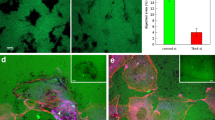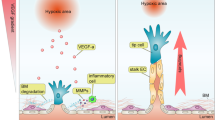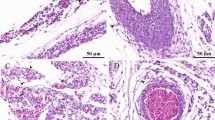Abstract
The formation of epithelial tubes is crucial for the proper development of many different tissues and organs, and occurs by means of a variety of different mechanisms1. Morphogenesis of seamless, properly patterned endothelial tubes is essential for the development of a functional vertebrate circulatory system, but the mechanism of vascular lumenization in vivo remains unclear. Evidence dating back more than 100 years has hinted at an important function for endothelial vacuoles in lumen formation2. More than 25 years ago, in some of the first endothelial cell culture experiments in vitro, Folkman and Haudenschild described “longitudinal vacuoles” that “appeared to be extruded and connected from one cell to the next”3,4, observations confirmed and extended by later studies in vitro showing that intracellular vacuoles arise from integrin-dependent and cdc42/Rac1-dependent pinocytic events downstream of integrin–extracellular-matrix signalling interactions5,6,7,8,9,10. Despite compelling data supporting a model for the assembly of endothelial tubes in vitro through the formation and fusion of vacuoles, conclusive evidence in vivo has been lacking, primarily because of difficulties associated with imaging the dynamics of subcellular endothelial vacuoles deep within living animals. Here we use high-resolution time-lapse two-photon imaging of transgenic zebrafish to examine how endothelial tubes assemble in vivo, comparing our results with time-lapse imaging of human endothelial-cell tube formation in three-dimensional collagen matrices in vitro. Our results provide strong support for a model in which the formation and intracellular and intercellular fusion of endothelial vacuoles drives vascular lumen formation.
This is a preview of subscription content, access via your institution
Access options
Subscribe to this journal
Receive 51 print issues and online access
$199.00 per year
only $3.90 per issue
Buy this article
- Purchase on Springer Link
- Instant access to full article PDF
Prices may be subject to local taxes which are calculated during checkout




Similar content being viewed by others
Change history
07 July 2006
The incorrect pdf version of this paper was posted online at publication. This was corrected 7 July 2006.
References
Lubarsky, B. & Krasnow, M. A. Tube morphogenesis: making and shaping biological tubes. Cell 112, 19–28 (2003)
Downs, K. M. Florence Sabin and the mechanism of blood vessel lumenization during vasculogenesis. Microcirculation 10, 5–25 (2003)
Folkman, J. & Haudenschild, C. Angiogenesis by capillary endothelial cells in culture. Trans. Ophthalmol. Soc. U. K. 100, 346–353 (1980)
Folkman, J. & Haudenschild, C. Angiogenesis in vitro. Nature 288, 551–556 (1980)
Bayless, K. J. & Davis, G. E. The Cdc42 and Rac1 GTPases are required for capillary lumen formation in three-dimensional extracellular matrices. J. Cell Sci. 115, 1123–1136 (2002)
Bayless, K. J., Salazar, R. & Davis, G. E. RGD-dependent vacuolation and lumen formation observed during endothelial cell morphogenesis in three-dimensional fibrin matrices involves the αvβ3 and α5β1 integrins. Am. J. Pathol. 156, 1673–1683 (2000)
Davis, G. E. & Bayless, K. J. An integrin and Rho GTPase-dependent pinocytic vacuole mechanism controls capillary lumen formation in collagen and fibrin matrices. Microcirculation 10, 27–44 (2003)
Davis, G. E., Bayless, K. J. & Mavila, A. Molecular basis of endothelial cell morphogenesis in three-dimensional extracellular matrices. Anat. Rec. 268, 252–275 (2002)
Davis, G. E., Black, S. M. & Bayless, K. J. Capillary morphogenesis during human endothelial cell invasion of three-dimensional collagen matrices. In Vitro Cell. Dev. Biol. Anim. 36, 513–519 (2000)
Davis, G. E. & Camarillo, C. W. An α2β1 integrin-dependent pinocytic mechanism involving intracellular vacuole formation and coalescence regulates capillary lumen and tube formation in three-dimensional collagen matrix. Exp. Cell Res. 224, 39–51 (1996)
Johnson, D. I. Cdc42: An essential Rho-type GTPase controlling eukaryotic cell polarity. Microbiol. Mol. Biol. Rev. 63, 54–105 (1999)
Hancock, J. F., Cadwallader, K. & Marshall, C. J. Methylation and proteolysis are essential for efficient membrane binding of prenylated p21K-ras(B). EMBO J. 10, 641–646 (1991)
Campbell, R. E. et al. A monomeric red fluorescent protein. Proc. Natl Acad. Sci. USA 99, 7877–7882 (2002)
Kamei, M., Isogai, S. & Weinstein, B. M. Imaging blood vessels in the zebrafish. Methods Cell Biol. 76, 51–74 (2004)
Weinstein, B. Vascular cell biology in vivo: a new piscine paradigm? Trends Cell Biol. 12, 439–445 (2002)
Lawson, N. D. & Weinstein, B. M. In vivo imaging of embryonic vascular development using transgenic zebrafish. Dev. Biol. 248, 307–318 (2002)
Isogai, S., Horiguchi, M. & Weinstein, B. M. The vascular anatomy of the developing zebrafish: an atlas of embryonic and early larval development. Dev. Biol. 230, 278–301 (2001)
Isogai, S., Lawson, N. D., Torrealday, S., Horiguchi, M. & Weinstein, B. M. Angiogenic network formation in the developing vertebrate trunk. Development 130, 5281–5290 (2003)
Torres-Vazquez, J. et al. Semaphorin-plexin signaling guides patterning of the developing vasculature. Dev. Cell 7, 117–123 (2004)
Childs, S., Chen, J. N., Garrity, D. M. & Fishman, M. C. Patterning of angiogenesis in the zebrafish embryo. Development 129, 973–982 (2002)
Kamei, M. & Weinstein, B. M. Long-term time-lapse fluorescence imaging of developing zebrafish. Zebrafish 2, 113–123 (2005)
Berry, K. L., Bulow, H. E., Hall, D. H. & Hobert, O. A. C. elegans CLIC-like protein required for intracellular tube formation and maintenance. Science 302, 2134–2137 (2003)
Buechner, M. Tubes and the single C. elegans excretory cell. Trends Cell Biol. 12, 479–484 (2002)
Manning, G. & Krasnow, M. in The Development of Drosophila melanogaster (eds Martinez-Arias, A. & Bate, M.) 609–685 (Cold Spring Harbor Laboratory Press, Cold Spring Harbor, New York, 1993)
Paul, S. M. & Beitel, G. J. Developmental biology. Tubulogenesis CLICs into place. Science 302, 2077–2078 (2003)
Rizzoli, S. O. & Betz, W. J. Synaptic vesicle pools. Nature Rev. Neurosci. 6, 57–69 (2005)
Sudhof, T. C. The synaptic vesicle cycle. Annu. Rev. Neurosci. 27, 509–547 (2004)
Carver, L. A. & Schnitzer, J. E. Caveolae: mining little caves for new cancer targets. Nature Rev. Cancer 3, 571–581 (2003)
Schnitzer, J. E. Caveolae: from basic trafficking mechanisms to targeting transcytosis for tissue-specific drug and gene delivery in vivo. Adv. Drug Deliv. Rev. 49, 265–280 (2001)
Westerfield, M. The Zebrafish Book (Univ. Oregon Press, Eugene, Oregon, 1995)
Acknowledgements
We thank J. Faske for technical assistance, G. Martin for help in constructing the mRFP1-expressing human ECs, K. Tanegashima for assistance with western blot analysis, R. Tsien for providing the mRFP1 vector, and I. B. Dawid for critical reading of this manuscript. This work was supported in part by a grant from the NIH to G.E.D. B.M.W. is supported by the intramural program of the NICHD.
Author information
Authors and Affiliations
Ethics declarations
Competing interests
Reprints and permissions information is available at npg.nature.com/reprintsandpermissions. The authors declare no competing financial interests.
Supplementary information
Supplementary Methods
Detailed descriptions of materials and methods used in this study. (DOC 68 kb)
Supplementary Movie Legends
Detailed legends for the Supplementary Movies. (DOC 52 kb)
Supplementary Movie 1
Time-lapse DIC imaging of cultured human umbilical vein endothelial cells forming, collapsing and fusing vacuoles. (MOV 2667 kb)
Supplementary Movie 2
Time-lapse DIC imaging of a single cultured human umbilical vein endothelial cell forming vacuoles that merge and expand into a highly enlarged vacuolar space. (MOV 2752 kb)
Supplementary Movie 3
Time-lapse 2-photon imaging of an embryonic zebrafish intersegmental vessel, with small vacuoles forming, collapsing and fusing. (MOV 4425 kb)
Supplementary Movie 4
Time-lapse 2-photon imaging of an embryonic zebrafish intersegmental vessel forming an expanded vacuolar/lumenal space. (MOV 4311 kb)
Supplementary Movie 5
Time-lapse 2-photon imaging of a lumenizing intersegmental vessel in a zebrafish embryo. (MOV 9109 kb)
Supplementary Movie 6
Time-lapse DIC imaging of a lumenizing intersegmental vessel in a zebrafish embryo. (MOV 7939 kb)
Supplementary Movie 7
Time-lapse DIC imaging of cultured human umbilical vein endothelial cells forming an intercellular space. (MOV 1783 kb)
Supplementary Movie 8
Time-lapse DIC imaging of cultured human umbilical vein endothelial cells forming an intercellular space. (MOV 9671 kb)
Supplementary Movie 9
Time-lapse epifluorescence imaging of cultured human umbilical vein endothelial cells forming an intercellular space without mixing of their respective cytoplasmic contents. (MOV 8120 kb)
Supplementary Movie 10
Time-lapse 2-photon imaging of red quantum-dot-injected embryonic zebrafish trunk vessels. (MOV 7650 kb)
Rights and permissions
About this article
Cite this article
Kamei, M., Brian Saunders, W., Bayless, K. et al. Endothelial tubes assemble from intracellular vacuoles in vivo. Nature 442, 453–456 (2006). https://doi.org/10.1038/nature04923
Received:
Accepted:
Published:
Issue Date:
DOI: https://doi.org/10.1038/nature04923
This article is cited by
-
Ink-structing the future of vascular tissue engineering: a review of the physiological bioink design
Bio-Design and Manufacturing (2024)
-
The interplay of cells, polymers, and vascularization in three-dimensional lung models and their applications in COVID-19 research and therapy
Stem Cell Research & Therapy (2023)
-
Hydrogels with tunable mechanical plasticity regulate endothelial cell outgrowth in vasculogenesis and angiogenesis
Nature Communications (2023)
-
Integrin α3β1 promotes vessel formation of glioblastoma-associated endothelial cells through calcium-mediated macropinocytosis and lysosomal exocytosis
Nature Communications (2022)
-
Synthetic extracellular matrices with tailored adhesiveness and degradability support lumen formation during angiogenic sprouting
Nature Communications (2021)
Comments
By submitting a comment you agree to abide by our Terms and Community Guidelines. If you find something abusive or that does not comply with our terms or guidelines please flag it as inappropriate.



